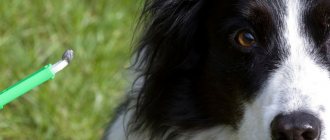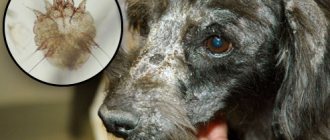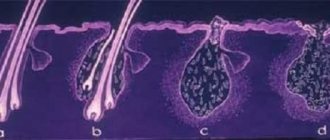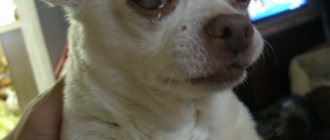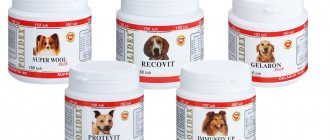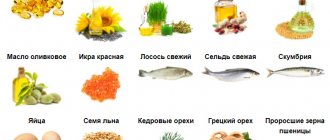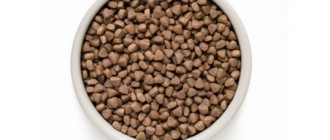Important building materials of the body are calcium and phosphorus. Thanks to them, teeth and bones gain strength, become healthy and strong. All dogs need such a trace element as calcium - regardless of breed, in young and mature pets. In puppies, the skeleton develops correctly during the period of intensive growth, in older dogs, bones are strengthened and pain is eliminated.
Caring owners understand how important it is to add calcium supplements to their pets' diets. Few people know that vitamins with calcium for dogs are not the same as those sold for people, and if you need to buy calcium for your dog, you should do this in specialized stores and only those supplements that are made specifically for pets.
Vitamin A (retinol)
Growth factor, support of vision and good skin condition, development of the animal’s skeletal system and improvement of reproductive functions
. Many associate vitamin A with carrots, and for good reason: an orange pigment, obtained specifically from red carrots at the beginning of the 20th century and called carotene, has vitamin A activity. Carotene is nothing more than provitamins, which are converted into vitamin A when they enter the body.
However, this does not mean that you need to feed your dog large quantities of carrots all the time. It’s a paradox, but it is carotene that is not absorbed in the body of these carnivores, which means it has absolutely no benefit. The most reliable product in this case can be called sea fish,
which owners often dislike due to its lower nutritional value and abundance of bones. Rational decision -
introduction of fish oil or oil-based vitamin A into the diet.
Excess calcium: why is it harmful?
Excess calcium in a dog’s body is just as harmful as too little. Many owners mistakenly think that their pet’s body absorbs exactly as much calcium as it needs, and the rest is excreted. This is not true: hormones affect the resulting supplement, the excess is deposited in bone joints. Rapid mineralization occurs, which leads to growth retardations and pathologies in the formation of the skeleton.
Overdoing it with a dose of calcium for pets is also bad. There is only one piece of advice: stick to the daily portion that your pet needs - a puppy, an adult or an elderly dog, and also take into account their health status.
B vitamins
This is the most “populous” category of vitamins involved in metabolism, normalization of the central nervous system and other vital systems of the dog’s body.
Raw meat
contains a sufficient amount of vitamins of this group.
As an additional source, it is recommended to introduce brewer's yeast
, which is called “brevers” (from a similar-sounding English word).
Today, Brevers are called B vitamins in general, since there is a whole series of preparations on the market based on brewer’s yeast and with various additives - the most famous representative of this category. Every owner must remember that Brevers are not a treat, and, like any other drug, they require careful adherence to the dosage, based on the characteristics of the dog’s body.
How to calculate the daily allowance
Many pet owners think that calculating the required dose of a particular beneficial ingredient is difficult. But this is far from true. Owners who feed their pets high-quality commercial food do not need to worry at all. All the necessary nutrients based on the age and other characteristic characteristics of the animal are included in the food composition.
Daily calcium requirement for a dog
In the production of industrial dry and soft food, compliance with the minimum and maximum calcium standards is monitored. The calculation is carried out in such a way as to cover the animal’s daily need for the mineral. For puppies, the norm is 320 mg per 1 kg of weight, with age the figure decreases to 120. The norm can be increased for old or sick pets.
It is not possible to replenish the calcium requirement for an animal with natural products. Even if you feed your dog high-quality meat, you will need more than 28 kg per day. Therefore, when feeding naturally, it is simply necessary to give the dog nutritional supplements and vitamin complexes.
We recommend this article:
Review of the line and assessment of the composition of Barking Heads dog food
Vitamin B1 (thiamine)
The so-called anti-neurological vitamin: its deficiency causes metabolic disorders with damage to the nervous and muscular systems, as well as the digestive tract
. In such cases, the animal literally “melts” before our eyes: appetite decreases, constipation, swelling and periodic convulsions appear, lethargy and weakness occur.
The most common causes of hypovitaminosis are chronic gastrointestinal diseases, leading to low absorption of vitamin B1. Nervous and physical stress, pregnancy and lactation, as well as illness and the introduction of more carbohydrates into the diet cause the need for additional intake of vitamin B1.
Thiamine is found in large quantities in plant foods: beans, nuts, root vegetables, cereals, fruits, and vegetables.
Vitamin B2 (riboflavin)
Vitamin B2 is the most important catalyst for metabolism
. Vitamin B2 deficiency in dogs is manifested by thinness, partial baldness of the back, areas around the eyes and ears, as well as clouding of the cornea (in severe chronic cases) and the appearance of cracks and inflammation of the mucous membranes.
Vitamin B2 is present in significant quantities in both plant tissues and animal products. Brewer's and dry yeast, liver, kidneys and heart are an excellent component of a dog's diet. Meat and dairy products are extremely important for pets raised at home
, which are 70% a source of vitamin B2 for dogs and should be the basis of the diet.
Kanvit
The Czech company Cenvit produces Biocal Plus - Calcium and collagen for dog bones and joints. The supplement contains Ca, phosphorus, sodium and collagen, necessary for the development and maintenance of the normal condition of bones, joints and tendons:
| Release form | Compound | Indications for use | Daily dose | Price |
| pills |
|
| per 5 kg of animal weight:
| 230 tab. – from 650 rub.; 500 tab. – from 1147 rub. 1 thousand tablets – from 1800 rub.. |
Vitamin B3 (pantothenic acid)
Vitamin B3 is the main regulator of the enzyme system of the animal body
. Hypovitaminosis B3 disrupts the activity of the endocrine glands and skin, causing dermatitis, hair loss and loss of brightness of its color, and also leads to pathological changes in the central nervous system.
A diet consisting exclusively of boiled or dry animal feed, as well as gastrointestinal disorders and liver disease are the most common causes of B3 vitamin deficiency. A sufficient amount of riboflavin is contained in yeast, liver and kidneys, as well as corn, wheat bran, and nuts.
In combination with vitamins C and B12, riboflavin is absorbed much better.
How to provide the necessary vitamins to your Yorkie?
Vitamins for your Yorkie can be given as a dietary supplement or dry food, or they can be part of natural foods. With a natural diet, the Yorkshire Terrier's food may include such necessary products as vegetable oil (fatty acids to improve coat quality).
Once a week you need chicken or quail yolk. A clove of garlic once a week will save your dog from worms. In winter, it is important to give your dog young shoots of oats. You can add a drop of honey to your Yorkie's porridge every other day. If the dog is fed super-premium food or its diet, in addition to high-quality food, includes useful natural substances in the menu and is well balanced, then you do not need to give any additional vitamins.
However, not everyone can afford quality, and therefore expensive food. And not everyone is ready to properly balance natural supplements. If the animal's diet is exclusively dry food of not the highest class, it will need a high-quality nutritional supplement. They vary, and the choice may depend on the dog's specific needs at different times.
Vitamin B6 (pyridoxine)
Pyridoxine normalizes the activity of the central nervous system and peripheral nervous system, and also regulates lipid, amino acid and carbohydrate metabolism.
The lack of this vitamin leads to serious consequences: stomatitis, seborrheic dermatitis, anemia and dysfunction of the digestive and endocrine systems.
Vitamin B6 deficiency is often observed in the first half of pregnancy in dogs that have had hepatitis or during long-term treatment. Decreased or complete loss of appetite and anxiety are the most common symptoms. The need to take vitamin B6 also appears during increased physical or mental stress.
Meat , liver, buckwheat and pearl barley, millet, all products of plant origin without exception, as well as fish and most types of cheese are rich in pyridoxine.
Vitamin B12 (cyanocobalamin)
Vitamin B12 is a factor in the growth and process of hematopoiesis
, which is why this vitamin is often called antianemic. Developmental delay, dysfunction of various organs, atrophy of the ovaries and testes are only a small part of the consequences caused by B12 vitamin deficiency.
The most common causes of vitamin B12 deficiency are a lack of meat, dairy and fish products, as well as long-term use of aggressive medications that negatively affect the gastrointestinal microflora. Therefore, it is important to provide your dog with food rich in vitamin B12: liver, fish (cod family), milk, cottage cheese. It is also recommended to introduce baker's yeast into the diet in small doses.
How to Give Calcium to a German Shepherd Puppy
You need to remember the main rule - calcium for a German Shepherd puppy is always used together with phosphorus. If you give calcium at normal phosphorus levels, then calcium begins to be washed out of the bones and rickets develops. The ratio of calcium to phosphorus should be 1:1 or 2:1; a combination of 3:1 is already dangerous and leads to rickets.
This can be solved by giving calcium glycerophosphate, which contains both microelements.
Reasons are also needed for giving calcium supplements, since an excess of it in the diet leads to hypercalcemia. Which is accompanied by lack of appetite, severe thirst, colic and constipation, nausea and vomiting. As a result, brain disorders, polyuria, and increased coagulation develop.
Orotic and pangamic acids (not everyone knows vitamins B13 and B15)
Orotic and pangamic acids are “engines” of metabolism, normalizing, among other things, liver function and participating in the process of hematopoiesis.
A lack of these vitamins can cause fatty liver (pathological accumulation of fats with subsequent weight gain in this organ) and anemia.
Deficiency of B13 and B15 in dogs is extremely rare. However, your diet should regularly include foods rich in these acids: baker's and brewer's yeast, liver of farm animals, beans, nuts.
Vitamin B9 (folic acid, folates)
Folic acid is a substance involved in the stimulation of the gonads, in metabolic processes and hematopoiesis, and also prevents the development of anemia and disorders of the central nervous system.
Lack of folic acid in puppies leads to slow growth, insufficient weight gain, dry skin and seborrhea. The dog's diet must necessarily include foods of plant and animal origin rich in vitamin B9: fruits, vegetables, buckwheat, nuts, liver, beef, cheese, red fish.
Phytocalcevitis
Mineral nutrition Fitocalcevit is produced in three versions - for puppies, young and older dogs. Suitable for animals fed both dry food and natural diet:
| Release form | Compound | Indications for use | Daily dose | Price |
| powder |
| provide the animal’s body with the substances necessary for normal development | Adult animals:
In case of stress, strain, or a weakened body, the dose can be doubled. Puppies:
| 500 g – from 80 rub. |
Vitamin C (ascorbic acid)
The level of immunity primarily depends on ascorbic acid
. Hypovitaminosis C is the most common condition in dogs, since the amount of this vitamin in many foods varies depending on the season (its content is lower in winter and spring). In addition, cooking and long-term storage of food partially destroy vitamin C.
Vitamin C deficiency manifests itself gradually: the dog becomes apathetic, lethargic, loses appetite, and over time, multiple hemorrhages and bleeding gums may occur. Therefore, your dog’s diet should include fruits, herbs and vegetables (potatoes, cabbage, spinach). The liver also contains a lot of vitamin C. Prevention and treatment of hypovitaminosis is carried out using a dosage form of vitamin C.
Vitamin D (cholecalciferol or simply calciferols)
forms immunity and regulates calcium-phosphorus metabolism
in the dog's body. Its deficiency can cause rickets (in puppies) and osteoporosis (in adult dogs). Yeast and fish oil are indispensable sources of vitamin D in the diet.
For the treatment and prevention of hypovitaminosis, oil-based vitamin D
in combination with ultraviolet baths, which in the warm season are quite capable of replacing natural sunlight during walks. In winter, you can use household devices for UV irradiation.
Reviews
Very often, dog owners are faced with a lack of understanding in which cases to use calcium gluconate, in what doses, how correctly and where to give the injection.
In such situations, you should carefully read the instructions for use and follow the veterinarian’s recommendations. After all, incorrect doses and forms of use can lead to an excess of the substance in the body, causing abscesses, necrosis and other unpleasant consequences, which can, unfortunately, lead to death.
Vitamin K (phylloquinone)
Vitamin K is directly involved in the blood clotting process.
A deficiency of this substance is observed in dogs with intestinal and liver diseases, as well as in puppies that do not receive enough vitamin K from their mother's milk. Vitamin K deficiency is manifested by numerous hemorrhages in the neck, back, sternum and hind limbs.
Spinach and kale contain large amounts of vitamin K
, and the dosage form is
the drug vikasol , treatment of which should be carried out under the supervision of a veterinarian.
Vitamin PP (nicotinic acid)
Vitamin PP is used for the treatment and prevention of dermatitis
, which appears on the skin as dark brown pigment spots, cracks and is accompanied by disruption of the central nervous system and diarrhea, resulting in depletion of the dog’s body.
Vitamin PP is prescribed for dry skin, inflammation of the gastrointestinal tract and some nervous diseases after suffering from the plague. At the same time, the dog’s diet includes the main sources of vitamin PP - fish, meat, liver of farm animals, cheese, legumes and yeast.
Vitamin menu for dogs
It's time to talk about vitamin and mineral complexes for dogs.
Oddly enough, there is no single classification of vitamin supplements for dogs, but for ease of understanding, all supplements can be divided into several groups:
· Vitamin and mineral preparations of general action
· Vitamin and mineral preparations with corrective action
· Vitamin and mineral preparations of enhanced action.
Each group is designed to prevent and solve a specific type of problem.
General action vitamins are general strengthening vitamin-mineral complexes, which include substances essential for the active life of a dog: vitamins A, E, C, D, B vitamins, as well as potassium, phosphorus, calcium and other useful micro- and macroelements.
The competently and carefully selected composition of the multivitamin complex has a beneficial effect on all systems and organs of the dog, strengthens the immune system and reduces the risk of infectious diseases. In addition, manufacturers delight pets with a variety of flavors of vitamin supplements: it can be liver, cheese, beef, salmon and other flavors.
A group of corrective vitamins for dogs was created to prevent diseases, improve the health of the body, and prevent or eliminate existing health problems. This also determines their composition: the drug may contain an increased content of specific substances necessary to achieve certain goals, or additional ingredients may be introduced that actively act directly on the problem area of the animal’s body.
Corrective vitamin supplements are nothing more than preparations for coat and skin, strengthening the musculoskeletal system, improving vision, reducing shedding time, etc. This category also includes vitamins for aging animals, for puppies and dogs of large and small breeds, which help maintain the animal’s vital activity at the proper level.
Enhanced action vitamins are designed for the most active dogs: training, working and fighting dogs. The same group is recommended for exhausted and weakened pets who have suffered injuries or infectious diseases, as well as during the recovery period after surgery.
These medications are based on a unique ratio of active beneficial substances that help strengthen the immune system, build muscle mass and increase the dog’s endurance level. This is a kind of “energy cocktail” that effectively restores the strength so necessary for an inquisitive and active dog.
For ease of use, vitamins for dogs are available in various dosage forms: paste, capsules, tablets, oil solutions, injections. Feed additives from well-known foreign companies such as “Canina” (Germany), “Beaphar” (Netherlands), as well as Russian products, “Tetravit”, “Omega” and many others are very popular.
Some features of calcium metabolism in dogs
Here is what veterinarians write about this: Large breed dogs develop differently and have different “risk zones” than medium and small breed dogs.
The main problems that owners of large teenage puppies face are problems of the limbs (osteochondrosis, arthritis and even arthrosis), as well as diseases of the tendon-ligament apparatus. These are very clear pathologies that are visible visually, without any additional research. Any passerby has more than once seen puppies and adult dogs of large breeds with an X-shaped rear limb. Often the owner of a large teenage puppy is faced with the following picture: unexpectedly, against the background of seemingly complete health, intermittent lameness, usually of the front limbs, begins. Severe soreness may develop after a few days. The animal is worried even when at rest. Any movement causes pain. Of course, a dog in this condition needs to be immediately shown to a veterinarian. An urgent surgical consultation is required here.
What is the cause of all these “troubles”?
First, a disease of intra-articular cartilage. The fact is that intra-articular cartilage is the most vulnerable part of the joint. The formation of joints in large breed dogs ends quite late, when the dog becomes almost an adult. Early and excessive sclerotization (that is, ossification of joints) leads to irreparable consequences. The main reason for these processes is an excess of calcium, hypervitaminosis (calcium level for puppies should be 0.8% per 100g of food, for adult dogs - 0.5%). Often the owner, wanting to help his pet, introduces a huge amount of all kinds of vitamin and mineral supplements into his dog’s diet, forgetting the old truth: everything is medicine - everything is poison. Any dosage form, be it an antibiotic or a vitamin-mineral preparation, must be prescribed by a veterinarian who monitors the animal and is responsible for all consequences, both positive and negative, from the use of the drug. Most commercially available commercial dog foods contain 1.2-2.5% calcium, with some foods containing more than 3%. The addition of even 1-2 teaspoons of calcium carbonate per day, when feeding animals with such feeds, leads to a significant increase in the level of calcium in the blood, which contributes to the development of hypertrophic osteodystrophy, hip dysplasia and other diseases, especially if the excess calcium is combined with an increased content in energy and protein intake.
When feeding puppies with complete industrial food intended for growing or lactating animals, additional calcium and phosphorus supplements are not required, as they can have a harmful effect on their health. In particular, excess calcium in the diet leads to hypercalcemia, hypophosphatemia and increased secretion of calciotonin. At the same time, bone resorption slows down, and the maturation of bone and cartilage tissue slows down. Clinically, this is manifested by osteochondrosis, curvature of the radius, lameness, and slow growth. Excess calcium in food leads to a decrease in the absorption of phosphorus, iron, zinc and copper in the intestines of dogs and their deficiency.
Quite often, puppies become deficient in zinc, especially when fed low-quality prepared foods with excessive levels of calcium and low zinc content. The skin of these puppies becomes scabby and flaky. At the same time, depigmentation of wool fibers, a decrease in the growth energy of animals, impaired growth of the testes and their degeneration are also observed. In addition, with a lack of zinc, regenerative processes slow down and disorders of the nervous system are noted, immunity is weakened, and bone formation is disrupted.
Long-term use of feed containing excess levels of calcium predisposes to acute dilatation of the stomach and intestines. This dangerous disease is familiar to many owners of large breed dogs with deep chests. In such animals, a constitutional predisposition to this disease, in combination with feeding low-calorie feeds, contributes to the occurrence of this disease. The development of this pathology is also facilitated by excessive calcium intake during pregnancy, lactation and animal growth.
Calcium stimulates the secretion of gastrin in the stomach and with excess calcium intake, gastrin hypersecretion becomes chronic. Gastrin increases the tone of the gastric sphincters (gastroesophageal and pyloric), which disrupts normal gastric motility and the evacuation of food from the stomach to the intestines. Long-term secretion of gastrin leads to hyperplasia and hypertrophy of the gastric mucosa in the pylorus area. This pathology is often observed in dogs prone to bloating. Hyperplasia of the mucosa and spasm of the pyloric sphincter disrupt the process of gastric emptying and gas release. At the same time, the contractility of the smooth muscles of the stomach decreases, which contributes to flatulence.
Thus, excessive intake of calcium by a female during pregnancy predisposes her offspring to gastric atony later in life. Excessive calcium intake by growing animals further exacerbates this process.
Some features of calcium metabolism in dogs.
In cynology, the issues of calcium metabolism are very acute. Firstly, the domestic dog, being completely dependent on humans both in feeding and in the level of physical activity, sometimes finds itself in non-physiological conditions of detention, which certainly has a pathological effect on metabolism, including calcium.
Secondly, a domestic dog, as an object of artificial selection, carries in its gene pool hereditarily fixed and, indirectly provided for by the breed standard, calcium metabolism features (bassets, dachshunds, great Danes, etc.), as well as genetic load in the form of partially or completely hereditary diseases. These may be dysplasia of the hip and elbow joints, progenia, osteochondrosis, deforming spondylosis, Lagg-Calv-Perthes disease, etc. In heavy, loose or fast-growing dogs, during the growth process, manifestations of a rickets-like disease are often observed, significantly reducing the exterior assessment and, as a result, breeding value of the animal.
Therefore, the question of a biologically competent approach to the issues of calcium metabolism in dogs, on the basis of which it is possible to develop an optimal strategy in solving issues of breeding and maintenance, arises especially acutely.
Calcium is one of the elements absolutely necessary for cells. About 40% of the total amount of calcium found in the blood plasma is associated with proteins, 40 - 50% is presented in the form of ions and approximately 10 - 20% in the form of complex compounds with organic substances.
The ionized form of calcium Ca2, associated with a specific protein calmodulin, is biologically active and is involved in many vital processes: conduction of nerve impulses, cell proliferation, stabilization of cell shape, muscle contraction, regulation of the activity of many enzymes, secretion processes, including hormonal. Calcium plays a vital role in the activity of the heart muscle, skeletal muscles, and vascular tone. The protein-bound and ionized forms are in dynamic equilibrium. The concentration of calcium in the blood plasma is closely related to the concentration of phosphorus and has an inverse relationship - an increase in the level of calcium in the blood leads to a decrease in the level of phosphorus.
Phosphorus is present in blood plasma in the form of sodium phosphate and compounds with organic substances (DNA, phosphatides, nucleic acids, etc.). Phosphorus ions are involved in the synthesis of high-energy compounds (ATP, etc.) that accumulate energy in the cell, are constituent elements of many enzymes, and, as part of complex phospholipids, participate in the construction of the cell membrane.
Calcium and phosphorus ions play a critical role in the formation of bone tissue structure and the functioning of the musculoskeletal system, which performs protective and support functions. Bone deposits significant amounts of calcium and phosphorus in the form of microcrystalline and amorphous hydroxyapatite, which provide the strength and structural characteristics of bone. Some calcium and phosphorus ions are washed out of the bone due to the destructive activity of osteoclast bone cells, while some, on the contrary, are included in the structure of bone tissue due to the synthetic activity of other bone tissue cells - osteoblasts. Calcium metabolism in the body of carnivores occurs very quickly. Strict regulation of calcium metabolism ensures the preservation of homeostasis (constancy of the internal environment of the body) and, consequently, the normal functioning of cells and the entire organism as a whole.
Calcium metabolism is influenced by hormones - parathyroid hormone, calcitonin and katacalcin, the hormonal form of vitamin D. In addition, sex hormones, growth hormones, adrenal and thymus glands influence.
Calcium metabolism can be represented as a dynamic complex of absorption processes - inclusion in biochemical processes and removal of corresponding ions from the body. The concentration of calcium in the blood, due to the functions it performs, is strictly regulated during the metabolic process.
Parathyroid hormone (parathyroid hormone), synthesized by the parathyroid glands, is a protein capable of mobilizing phosphorus-calcium depots in bone tissue, increasing the concentration of calcium in the blood. In the renal tubules, parathyroid hormone causes increased reabsorption of calcium ions and also inhibits the reabsorption of phosphorus. All this leads to an increase in calcium levels and a decrease in the concentration of phosphorus in the blood.
The sphere of influence of parathyroid hormone also includes the processes of calcium absorption in the intestines. Changes in the production of parathyroid hormone occur with sudden changes in the concentration of calcium in the blood. For example, an increase in the concentration of ionized calcium leads to a decrease in the synthesis of parathyroid hormone. Lack of parathyroid hormone causes a decrease in the concentration of ionized calcium in the blood and when it falls below 6 mg%, dogs experience seizures, which are easily stopped by the administration of calcium supplements.
Excess parathyroid hormone (primary and secondary hyperparathyroidism) leads to demineralization and resorption of bone tissue, calcium deposition in the walls of blood vessels and the excretion of large amounts of calcium by the kidneys, which causes urolithiasis.
Calcitonin and katacalcin are classified as calcium-lowering hormones. Both hormones are protein in nature and are synthesized by the C-cells of the thyroid gland. An increase in the secretion of calcitonin and katacalcin occurs in response to an increase in the concentration of calcium, as well as gastrin and cholecystokinin in the blood. These hormones inhibit the activity of osteoclasts that resorb bone tissue, which leads to a rapid decrease in the level of calcium and phosphorus in the blood.
Vitamin D represents a group of structurally similar compounds (ergocalciferol - vitamin D2 and cholecalciferol - vitamin D3, dihydrocalciferol - vitamin D4). The most important role in calcium metabolism is played by the hormonal form of vitamin D3, which is 1,25-dihydroxycholecalciferol. Under the influence of 1,25-dihydroxycholecalciferol, intestinal epithelial cells increase the synthesis of a protein capable of absorbing calcium ions and transferring them into the blood. In the process of calcium absorption, the activation of enzymes involved in the transfer of ions through the cell membranes of the intestinal epithelium, carried out by parathyroid hormone, also plays an important role. Physiological concentrations of vitamin D in the blood promote the resorption of old bone tissue and the transfer of calcium ions to the sites of formation of new bone tissue. At the kidney level, they accelerate the reabsorption of calcium and phosphorus ions in the renal tubules, thereby preventing their loss in the urine.
It is generally accepted that a lack of vitamin D causes rickets in puppies, and osteomalacia in adult dogs, otherwise called English disease or Gleason's disease in the West, and also leads to dysfunction of many organs. This occurs due to changes in intracellular metabolism, in particular disruptions in the functioning of intracellular membranes, and a decrease in protein synthesis. The course of the disease is aggravated by insufficient intake of calcium and phosphorus from food. Unlike humans, the synthesis of vitamin D in dogs during solar irradiation is insignificant. This is decisive for the absolutely necessary supply of this vitamin with food or in the form of pharmaceuticals. Every day, for every kg of body weight, a puppy needs approximately 20 units of vitamin D, 529 mg of calcium and 441 mg of phosphorus. For adult dogs, these amounts can be halved. Also, to prevent rickets, a physiological ratio of calcium and phosphorus supplied with food is necessary (from 2:1 to 1:1, on average 1.2:1).
A sufficient level of physical activity, stimulating metabolism, will ensure the inclusion of absorbed calcium in the bone tissue.
An overdose of vitamin D and mineral preparations with food or in the form of pharmaceuticals - gluconate, glycerophosphate, calcium lactate during the growth period of a puppy (especially large and fast-growing breeds) leads to the appearance of often irreversible nutritional secondary hyperparathyroidism, which externally, if poorly diagnosed, resembles rickets in its clinical manifestations. This disease is often observed with an insufficiently competent approach to growing and using homemade mineral supplements or the simultaneous use of fortified dry food and premixes or vitamin preparations.
Calcium metabolism is also associated with vitamin C metabolism, which helps normalize bone structure. Unlike humans, vitamin C is synthesized in the dog’s body independently and does not require mandatory intake from food.
Much attention should be paid to the motor mode of dogs during the formation of the musculoskeletal system. Absolutely unacceptable for puppies of large and loose breeds is early training in jumping over a barrier, games with driving the dog on its hind legs. For puppies of various greyhounds, jumping from heights is undesirable. The requirement of many breeders to keep puppies on a hard, non-slip floor (no parquet or linoleum) is justified. Dosed physical activity during walks at a variable pace of movement plays an important role - in this case, metabolic processes in bone and muscle tissue are optimized.
It follows that a competent approach to feeding, maintenance and pharmacological correction of calcium metabolism disorders that have arisen is of decisive importance in raising healthy dogs. Calcium metabolism disorder
The parathyroid glands, attached to each lobe of the thyroid gland, are responsible for calcium metabolism. With a decrease in ionized calcium in the serum, parathyroid hormone is produced, which increases calcium reabsorption and phosphorus excretion in the distal tubules of the kidneys. Parathyroid hormone stimulates alpha-hydroxylase activity in kidney tubular cells, which increases the synthesis of calcitriol, the active form of vitamin D3.
Disturbances in calcium metabolism in small pets lead to hypercalcemia, hypocalcemia, and normocalcemia with excessive bone resorption.
Hypercalcemia
very common in dogs. It can be caused by malignant neoplasms, observed in Addison's disease, chronic renal failure, parathyroid adenoma, and vitamin D toxicosis.
Currently, an analysis is being carried out for parathyroid hormone and ionizing calcium levels. Hypercalcemia causes acute renal vasoconstriction and ischemic renal damage. It has an antagonistic effect on antidiuretic hormone, causing nephrogenic diabetes insipidus.
Hypercalcemia causes nephrocalcinosis
– calcium deposition in kidney tissue. Animals whose calcium x phosphorus derivative is greater than 5.0-6.0 require immediate treatment to prevent irreversible changes in the kidneys. Emergency treatment includes placing droppers: 0.9% sodium chloride solution, which effectively stimulates calciuresis. Diuretics are used: furosemide, etc. (except for thioside diuretics), diuretics should not be used. Sodium bicarbonate is also prescribed, because it reduces the concentration of total serum calcium.
For hypercalcemia, the use of glucocorticoids, prednisolone or dexamethasone is indicated, because they reduce the reabsorption of calcium from the bone and the absorption of calcium in the intestine, and increase the excretion of calcium by the kidneys. Calcitonite also reduces serum calcium concentrations, but its effect is short-lived. Now in veterinary medicine they are trying to use bisphosphonates to lower calcium.
Hypocalcemia
– is a lack of calcium in the serum (less than 2 mmol/l). Animals may have tremors, twitching, muscle spasms, stiffness, and epilepsy occurs as a consequence of increased excitability of the central nervous system. Aggression, anxiety, and heavy rapid breathing may also be observed. Some animals may have bradycardia, fever, polyuria and polydipsia with vomiting.
After birth, postpartum tetany often occurs in small breeds of dogs: a lot of calcium is spent on the formation of the skeleton of the fetus and then calcium is lost in milk in lactating animals. It may appear in the first three weeks after birth, sometimes later. The rate of calcium utilization exceeds the ability of homeostatic mechanisms to maintain the concentration of ionized calcium in the serum. The dog is breathing frequently, shaking, the temperature rises, weakness of the hind limbs and nervous disorders are observed. If help is not provided in time, the animal dies.
Treatment with calcium begins immediately, intravenous administration of calcium gluconate 10% is used, cardiac drugs are used: sulfocamphocaine, magnesium sulfate 25% is administered intramuscularly. Then calcium supplements are prescribed orally. If the puppies are not feeling well, they are taken away from the bitch. Postpartum tetany can also occur in cats that give birth 3-4 times a year.
Another cause of hypocalcemia is hypoparathyroidism
– constant parathyroid hormone deficiency. This often happens when the thyroid gland is removed, a tumor on the parathyroid gland is removed, or the parathyroid gland is removed or injured. Spontaneous hypoparothyroidism is also possible and is characterized by complete destruction and atrophy of the parathyroid gland. This disease is rare in dogs and cats and requires lifelong treatment with calcium and vitamin D.
Of the three available vitamin D preparations, dehydrotachysterol, a synthetic form of vitamin D, is most preferable to ergocalciferol (vitamin D2), as it increases serum calcium levels more quickly, and in the event of hypercalcemia, discontinuation of the drug is more effective. The main complication in the treatment of chronic hypoparathyroidism is hypercalcemia, then the supply of calcium and vitamin D is stopped for a while, and resumed if the calcium level again falls below 2 mmol/l.
Primary hypoparathyroidism
is a rare syndrome that has been reported in both dogs and cats. It is caused by idiopathic atrophy of the parathyroid gland. It can be registered in both adults and young animals. Toy poodles, miniature schnauzers, terriers, Labrador retrievers and German shepherds are predisposed. A decrease in calcium (less than 1.6 mmol/l) leads to epileptic seizures.
A severe condition of hypocalcemia occurs in large breed dog puppies aged 2-5 months. The puppy sits on its hind legs, is afraid to get up, and whines. If help is not provided, spontaneous bone fractures, thickening of the costochondral joints, metaphyses, and deformation of the limbs may occur.
This disease is characterized by excessive bone resorption and signs of osteopenia. Develops as a result of feeding a diet with excess phosphate content and low calcium content. Usually this is a diet consisting of meat and tripe, the ratio of calcium to phosphates is 1:16 - 1:35 (standards 1.2:1 for dogs; 1:1 for cats). Such animals need complete rest for several weeks.
It is better to switch to feeding balanced ready-made diets. Additionally they give calcium. In severe cases, intravenous injections of calcium gluconate are used. After 5-7 injections, the pain disappears. The mineralization of the skeleton itself is restored slowly, over several months.
You should not abuse calcium supplements, because... this can lead to calcification of the renal pelvis and other organs. Excess calcium can lead to hyperkeratosis of the skin: especially in the areas of the elbow and hock joints.
Chief veterinarian of the veterinary clinic “KIBELA” Fokicheva Anna Pavlovna.
Disorders of calcium metabolism and diseases associated with it
During my rather long period of relationship with dogs, I have encountered various forms of calcium metabolism disorders caused by vitamin deficiency in vitamins “D”, “C”; disruption of the thyroid gland and leading to various serious diseases, including various forms of rickets. The degree of decalcification ranges from barely noticeable changes in the limbs - 0-shaped curvatures and barely palpable beads on the ribs to very severe forms, when a young dog at the age of 7 - 8 months had a head and body corresponding to its age, and the limbs were unnaturally short. The front ones are 0 - figuratively curved, and the rear ones have close hocks and weak ligaments. The ribs are strongly defined, and the chest shape, instead of oval, approaches barrel-shaped. In general, a 7-8 month old puppy gave the impression of a 4 month old one. The fur is dull and tousled. In general, this is a classic picture of rickets. Moreover, I have always been amazed by the careless attitude of dog owners towards this disease. Basically, dog owners are of the opinion that “let’s take a walk in the sun, give injections of Trivit or Tetravit and rickets will go away without a trace.”
However, this is a very dangerous misconception, and I had to see from my own sad experience what rickets is and how it ends. When I once again had the question of which dog to get and at what age (alas, a dog’s life is not long), I chose a 10-month-old male German Shepherd from Almaty named Dalcao Rimbaud. I had not seen the dog until the moment of meeting me at Tashkent Airport and completely relied on the opinion of the people who recommended that I buy it. The male was large with sufficient bone structure, somewhat straight shoulders with a beautiful head, but rather thin. It was 1989 and at that moment it was believed that a German Shepherd must have visible ribs and should run a lot from an early age, and at a stretch. Rimbaud, as it turned out later, was a prominent representative of such dogs - he was chased a lot and fed poorly. I soon noticed that something was wrong with him. The dog had an increased appetite, a perversion of appetite - he gnawed bricks, earth, and most importantly, he ate his own feces. The sight was not pleasant. In addition, he got tired very quickly. He could work for no more than 15 - 20 minutes, and then he would lie down and refuse to follow commands. I began to suspect that it was rickets. I turned to A.R. Novokreshchenov for advice at the zoo’s veterinary clinic. and he confirmed my suspicions and recommended a course of treatment using vitamin D with mandatory exposure to the sun, especially in the morning, when UV radiation, rather than thermal radiation, predominates. I was fine with UV radiation - the male lived in an enclosure, and besides, I walked with him a lot. To carry out a course of treatment with vitamin D, as was recommended to me, I began to give 1 - 2 drops of vitamin D in oil to food. But one day I gave the drug as recommended in the instructions - 1 - 2 drops per piece of bread. After about three hours, Rimbaud refused to eat and became lethargic and slow. I decided that the heat was to blame - it was July, the heat was forty degrees, and the dog was brought in at the beginning of May and he probably still had not adapted to our conditions. However, in the morning he was no longer alive. On this occasion, I again turned to A.R. Novokreshchenov. for clarification and received an oral conclusion that in severe forms of rickets organic changes occur in the liver and heart and vitamin D becomes a deadly poison
.
Now regarding UV radiation. In dogs, just like in humans, when exposed to ultraviolet rays, the skin produces provitamin D from lipids, vitamin D itself. We have enough sun, but there are not fewer rickety dogs. Basically, rickets occurs in young dogs, puppies, and 100% rickets is observed after any infectious diseases that affect the intestines - canine distemper, viral enteritis, gastroenteritis, parovirus, hepatitis, as well as severe poisoning and especially organochlorine poisoning, which disrupts the activity of not only the intestines, but also the kidneys.
In this regard, it is necessary to dwell in more detail on the causes of calcium metabolism disorders. RICKETS is a disease caused by a lack of vitamins “D” and “A” and the resulting disturbance of phosphorus-calcium metabolism. First of all, the absorption of calcium in the intestines and its deposition in the bones are disrupted. As a result, the bones of the limbs are bent, and characteristic “rosary beads” are formed on the ribs, the functions of the nervous system and internal organs are disrupted, and muscle atrophy often occurs. In severe and advanced forms of the disease, organic changes occur in the heart and liver. Dogs affected by rickets experience a perversion of appetite - eating inedible things - soil, licking walls, eating their own feces. In addition, such dogs are physically weak, get tired quickly and are not able to assimilate the trainer’s commands well. The only first aid is to prevent rickets, since treatment does not always make it possible to recover.
CAUSES OF RICKETS: · hereditary rickets is caused by a disorder at the chromosomal level. · poor nutrition—lack of vitamin “D” in food, as well as vitamin “A”; those. the predominance of plant substances in food, a vegetarian diet, a diet with a predominance of cereals, the so-called “life-prolonging diets”.
In particular, rickets is quite common in people in countries with a traditional predominance of vegetarian diets. India is primarily one of these countries. There is enough sun and ultraviolet radiation there, however, traditional food is vegetable with insufficient amounts of fat and fat-soluble vitamins and especially vitamin D. In dogs, a large percentage of rickets is also observed with poor nutrition in cases where dogs are fed porridge, bread, leftover food from your desk. All of these foods contain very few nutrients needed by carnivores.
Diseases of rickets associated with diseases of the gastrointestinal tract. In these cases, the absorption of calcium in the intestine is disrupted, and the enterohepatic circulation of vitamin D and its metabolites is also disrupted. These diseases are especially dangerous for puppies at the time of their rapid growth, when the dog grows by 2 cm per week and at this moment irreversible changes occur very quickly - within 10 - 20 days. However, even with proper and timely treatment of rickets after infectious diseases, the process cannot be stopped. This is also connected with vitamin “C” - ascorbic acid, which plays a large role in metabolism. Ascorbic acid plays an important role in the synthesis of collagen, the connective tissue that forms the basis of ligaments in joints. In dogs, ascorbic acid is produced by the intestinal microflora and in case of any infectious diseases, this microflora dies, ascorbic acid ceases to be produced and enters the body.
Therefore, after any infectious diseases, dogs also have very weak ligaments in the front and hind limbs, back, and the dog wobbles in all directions when walking, as if on “hinges.” In addition, the absence of ascorbic acid leads to the occurrence of a serious disease - scurvy, also associated with impaired calcium metabolism. Often there are no external signs of the disease yet, but there is already a disturbance in calcium metabolism and this leads to changes in the normal structure of bone tissue. So on the ribs, at the border between the cartilage and the bone itself, swellings, “rosaries” are formed, similar to the “rosary” in rickets itself.
You should also dwell on dental damage - caries. The causes of caries have not been precisely established, but it always occurs with any disturbances of calcium metabolism, lack of vitamins, or disruption of the activity of the endocrine glands. 100% caries damage occurs in young dogs and puppies with any infectious diseases. The thyroid and parathyroid glands play an important role in the regulation of calcium metabolism, the functions of which depend on the presence of iodine in food. Calcium forms the inorganic part of bone, mainly in the form of hydroxylopatite Ca5(PO4)3OH, which is deposited on a protein base. With a lack of iodine, there is a decrease in the function of the thyroid gland, the level of calcitonin, which inhibits the dissolution of bone calcium, decreases, which also leads to the occurrence of rickets-like phenomena.
Prevention of calcium metabolism disorders:
· proper, balanced nutrition necessary for carnivorous canines. Be sure to have fats, proteins, etc., containing vital vitamins. · A long period of rehabilitation after any infectious diseases affecting the gastrointestinal tract, including the use of medications such as B-complex preparations, glucose, calcium ascorbic acid glucanate, as well as the use of drugs that restore intestinal microflora. In the absence of such, a good result is obtained by using ordinary sour milk aged for a day, but not peroxidized. It contains enough necessary microflora, which is characteristic of a normally functioning intestine, and it is also adapted to our conditions. · mandatory inclusion of drugs containing iodine in the diet, because in our region its content is reduced. This is especially true for dogs imported from other regions.
Choosing a vitamin preparation for a dog
If you select industrial food for your pet taking into account its physiological characteristics and age, with proper feeding, the risk of vitamin deficiency and health problems in your dog is minimal. But the introduction of vitamin-mineral complexes into the diet is extremely necessary, especially in the case of a mixed diet or a menu that includes exclusively home-cooked dishes.
For reference, below you will find a description of the most well-known foreign-made drugs that are in great demand among many dog owners.
· Vitamins for dogs “8in1” – a line of American food supplements for various purposes: to strengthen and stimulate the immune system, correct physical condition, intensively restore the dog’s body, etc. Available in the form of pastes, tablets, oils, sprays, food additives.
· “Adult Multi Vitamin” (Adult Multi Vitamin) is a highly effective complex for adult dogs, characterized by a high concentration of B vitamins and an optimal ratio of phosphorus and calcium. The drug was created to replenish nutrients in the dog’s body on a daily basis. Fat-soluble vitamins in the complex (A, D and E) increase the absorption and assimilation of micro- and macroelements. The complex is especially recommended in the cold season for the prevention of hypovitaminosis, as well as in case of an unbalanced diet.
· “Brewers Yeast with Garlic” (brewer's yeast with garlic) – indicated for metabolic disorders, lack of B vitamins, stress conditions and problems with the immune system. This is a hypoallergenic drug that does not contain artificial ingredients, recommended both for puppies and when preparing any dogs for vaccination. The drug is also a means of preventing helminthiasis.
· Vitamins "POLIDEX" (Polidex) were developed by the British pharmaceutical company. Each drug has a targeted effect and is available in the form of tablets in light, convenient packaging.
· “GelaBon plus” (Gelabon plus) are intended to strengthen joints, ligaments, hair and claws, and increase skin elasticity. The main active component of the drug is collagen hydrolyzate, which is fully absorbed by the body practically without digestion and regulates phosphorus-calcium metabolism. The drug is hypoallergenic and does not have a negative effect on the gastrointestinal tract.
· “Multivitum plus” (Multivitum plus) is a vitamin and mineral complex recommended for the prevention of hypovitaminosis, increasing immunity, normalizing oxygen metabolism, destroying and removing toxins, as well as to compensate for the lack of micro- and macroelements in an unbalanced diet. Provides support for all body systems thanks to the interconnected action of active substances (by the way, the drug contains iodine, selenium, magnesium, iron, which are important for the dog’s body).
· Vitamins “Beaphar” (Biphar) – Dutch food supplements for dogs, produced in powder form. Designed to solve a wide range of problems: from general health promotion to supporting the body during growth, recovery after surgery and in stressful situations.
· “Top 10” (Top Ten) is a popular balanced complex of vitamins and minerals for dogs. Feed additive recommended for supporting the immune system and increasing vitality. The active component L-carnitine promotes the proper development of the skeletal system and teeth in puppies, and also helps maintain vigor and flexibility in adult dogs.
Making YEAST at home.
As you have already read, almost all B vitamins are found in baker's yeast. But we will tell you how best to prepare them for dogs:
You will need one cube of wet yeast: Place it in a small ladle or saucepan. Place this saucepan in a larger saucepan filled with water (steam bath) and place on low heat. Stir the yeast constantly. They should dissolve and begin to bubble vigorously. During the bubbling process, fermentative substances are released. As soon as the yeast finishes bubbling, remove from heat, pour the homogeneous mass into a jar, cool and put in the refrigerator. You have an excellent, natural source of B vitamins. Give ½ teaspoon once a day with food.
Of course, the list of drugs is far from complete. But, when choosing a drug for a pet and relying on the recommendations of friends and ratings, every owner must remember that vitamins suitable for a dog are not the “best” and not the “most expensive” in the line available on the market. The vitamin and mineral complex is selected strictly individually.
Only a specialist can confirm the need to take vitamins and give detailed recommendations for taking them, based on the results of your pet’s examination.
Excel with calcium
Calcium supplements for dogs are produced by the German company Pet Products GmbH. Excel Calcium 8 in 1 food supplement is designed for puppies and adult animals, incl. lactating and pregnant bitches:
| Release form | Compound | Indications for use | Daily dose | Price | |
| pills | active ingredients |
| designed to provide the animal with the required amount of Ca, phosphorus, D3 |
Give the supplement for 2–4 weeks, then take a break | 155 pcs. – from 300 rub.; 470 pcs. – from 780 rub.; 880 pcs. – from 1400 rub.; 1700 pcs. – from 2800 rub. |
| Excipients |
| ||||

